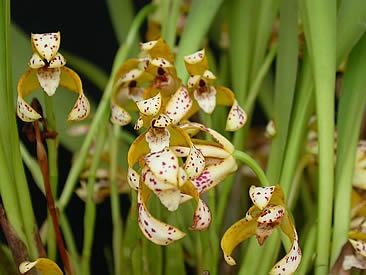The Painted Maxillaria (Brasiliorchis picta) is an orchid with delicate painted flowers that emit a delightful honey fragrance. It is native to the southern and southeastern regions of Brazil, thriving at altitudes of 200 to 600 meters, either as an epiphyte (on trees) or as a lithophyte (on rocks). The pseudobulbs are fusiform in shape and can be short or elongated. The rhizome is strong, short, and highly branched, forming densely packed clumps.
It typically presents two leaves at the apex of the pseudobulb. Inflorescences emerge in late winter and early spring. In large clumps, a considerable number of flower stems can be appreciated, arising from the base of the plant. The flowers are small, ranging from 3.5 to 5 cm in diameter. They are white to yellow, with spots of red or orange. The lip also has reddish rays.
Cultivate the Painted Maxillaria in wide and shallow pots, allowing it to form a large clump. During flowering, the plant can adorn interiors with all its grace and beauty. It also thrives when tied under the canopy of trees, where its adaptation is excellent. Just ensure that the chosen tree preferably does not have peeling bark or is deciduous. It is an intriguing orchid for use in vertical gardens, given its clumping appearance and epiphytic habit.
It should be grown in partial shade or full sun, in a substrate suitable for epiphytes—well-draining but with good moisture retention capacity. Partial shade is preferable, especially in hot climates. In subtropical or temperate regions, full sun is also possible. Ideally, for orchidariums with controlled lighting, a 50% shading condition is recommended.
Prefer wooden or ceramic pots with a substrate composed of fiber and coconut husk, mixed with gravel and ceramic shards or stones. Fertilize during growth and flowering with orchid-specific fertilizers, complemented by organic fertilizers based on bokashi or seaweed. The Painted Maxillaria propagates through seeds but mainly through clump division, ensuring each new plant has at least three pseudobulbs and a shoot. In large commercial nurseries, multiplication occurs through meristematic cloning, carried out in the laboratory.


